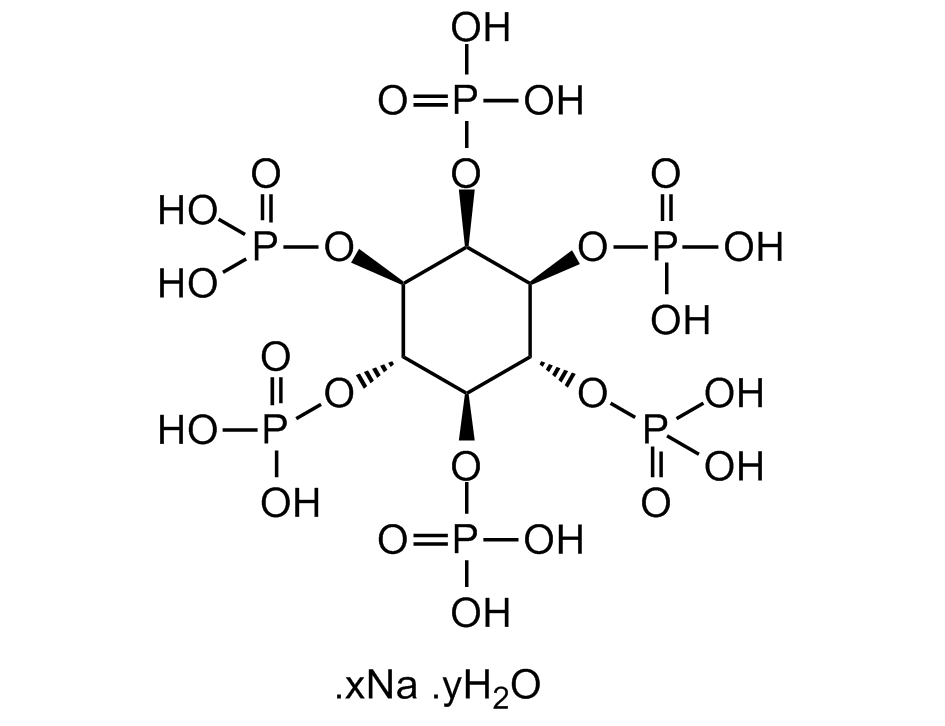Phytic acid . sodium salt . hydrate
Product Code: AG-CN2-0528
Product Group: Natural Products and Extracts
Supplier: AdipoGen Life Sciences
| Code | Size | Price |
|---|
| AG-CN2-0528-M025 | 25 mg | £45.00 |
Quantity:
| AG-CN2-0528-M100 | 100 mg | £95.00 |
Quantity:
Prices exclude any Taxes / VAT
Overview
Regulatory Status: RUO
Shipping:
Ambient
Storage:
-20°C
Images
Documents
Further Information
Alternate Names/Synonyms:
D-myo-Inositol-1,2,3,4,5,6-hexaphosphate sodium salt hydrate; IP6
Appearance:
White solid.
CAS:
14306-25-3 (anhydrous)
EClass:
32160000
Form (Short):
liquid
Handling Advice:
Protect from moisture.
InChi:
InChI=1S/C6H18O24P6/c7-31(8,9)25-1-2(26-32(10,11)12)4(28-34(16,17)18)6(30-36(22,23)24)5(29-35(19,20)21)3(1)27-33(13,14)15/h1-6H,(H2,7,8,9)(H2,10,11,12)(H2,13,14,15)(H2,16,17,18)(H2,19,20,21)(H2,22,23,24)/t1-,2-,3-,4+,5-,6-
InChiKey:
IMQLKJBTEOYOSI-GPIVLXJGSA-N
Long Description:
Chemical. CAS: 14306-25-3 (anhydrous). Formula: C6H12O24P6 . xNa . yH2O. MW: 660.0 (anhydrous free acid). Isolated from Oryza sativa. Direct activator of necroptosis inducer MLKL (mixed lineage kinase domain-like). Necroptosis is an inflammatory form of programmed cell death executed through plasma membrane rupture by the pseudokinase mixed lineage kinase domain-like (MLKL). Addition of IP6 promotes membrane permeabilization by MLKL through directly binding of the N-terminal executioner domain (NED) and dissociating its auto-inhibitory region. IP6 is a phosphate ester of inositol (Ins) and precursor for second messengers in cell signaling. Iron (Fe) Chelator that binds also to Ca, Mg, Zn. Considered as an anti-nutritional component in cereals, seeds and beans that binds these minerals and prevents their absorption in the gastrointestinal tract. Formulations containing phytic acid have been used as preservatives in food production. Antioxidant with anticancer, anti-inflammatory, antidiabetic, neuroprotective, hypocholesterolemic and hypolipidemic effects. Shown to inhibit lipid peroxidation and inhibits proliferation of a variety of cancer cells in vitro and reduces tumor growth in rodent xenograft models. Increases insulin sensitivity in adipocytes by increasing lipid storage capacity, improving glucose uptake and inhibiting lipolysis. Shown to have in vitro and in vivo antidiabetic activity. Shown to modulate gut microbiota and to have a key role in several stages of the HIV-1 lifecycle from assembly to uncoating.
MDL:
MFCD00082310
Molecular Formula:
C6H12O24P6 . xNa . yH2O
Molecular Weight:
660.0 (anhydrous free acid)
Package Type:
Vial
Product Description:
Direct activator of necroptosis inducer MLKL (mixed lineage kinase domain-like). Necroptosis is an inflammatory form of programmed cell death executed through plasma membrane rupture by the pseudokinase mixed lineage kinase domain-like (MLKL). Addition of IP6 promotes membrane permeabilization by MLKL through directly binding of the N-terminal executioner domain (NED) and dissociating its auto-inhibitory region. IP6 is a phosphate ester of inositol (Ins) and precursor for second messengers in cell signaling. Iron (Fe) Chelator that binds also to Ca, Mg, Zn. Considered as an anti-nutritional component in cereals, seeds and beans that binds these minerals and prevents their absorption in the gastrointestinal tract. Formulations containing phytic acid have been used as preservatives in food production. Antioxidant with anticancer, anti-inflammatory, antidiabetic, neuroprotective, hypocholesterolemic and hypolipidemic effects. Shown to inhibit lipid peroxidation and inhibits proliferation of a variety of cancer cells in vitro and reduces tumor growth in rodent xenograft models. Increases insulin sensitivity in adipocytes by increasing lipid storage capacity, improving glucose uptake and inhibiting lipolysis. Shown to have in vitro and in vivo antidiabetic activity. Shown to modulate gut microbiota and to have a key role in several stages of the HIV-1 lifecycle from assembly to uncoating.
Purity:
>98%
SMILES:
O=P(O)(O)O[C@H]1[C@@H](OP(O)(O)=O)[C@H](OP(O)(O)=O)[C@@H](OP(O)(O)=O)[C@H](OP(O)(O)=O)[C@H]1OP(O)(O)=O
Solubility Chemicals:
Soluble in water (50mg/ml).
Source / Host:
Isolated from Oryza sativa.
Transportation:
Non-hazardous
UNSPSC Category:
Natural Products/Extracts
UNSPSC Number:
12352200
Use & Stability:
Stable for at least 1 year after receipt when stored at -20°C.
References
Phytic acid. A natural antioxidant: E. Graf, et al.; J. Biol. Chem. 262, 11647 (1987) (Review) | Antioxidant functions of phytic acid: E. Graf & J.W. Eaton; Free Radic. Biol. Med. 8, 61 (1990) (Review) | Hypolipidemic action of phytic acid (IP6): prevention of fatty liver: T. Katayama; Anticancer Res. 19, 3695 (1999) (Review) | Phytic acid (IP6), novel broad spectrum anti-neoplastic agent: a systematic review: C.H. Fox & M. Eberl; Complement. Ther. Med. 10, 229 (2002) (Review) | Inhibition of xanthine oxidase by phytic acid and its antioxidative action: S. Muraoka & T. Miura; Life Sci. 74, 1691 (2004) | Neuroprotective effect of the natural iron chelator, phytic acid in a cell culture model of Parkinson's disease: Q. Xu, et al.; Toxicology 245, 101 (2008) | Effect of phytic acid and inositol on the proliferation and apoptosis of cells derived from colorectal carcinoma: L. Schroeterova, et al.; Oncol. Rep. 23, 787 (2010) | Phytic acid as a potential treatment for alzheimer's pathology: evidence from animal and in vitro models: T.S. Anekonda, et al.; J. Alzheimers Dis. 23, 21 (2011) | In vitro (a-glucosidase and a-amylase inhibition) and in vivo antidiabetic property of phytic acid (IP6) in streptozotocin- nicotinamide-induced type 2 diabetes mellitus (NIDDM) in rats: A. Kuppusamy, et al.; J. Complement. Integr. Med. 8, 9 (2011) | Phytic acid inhibits lipid peroxidation in vitro: A. Zajdel, et al.; Biomed. Res. Int. 2013, 147307 (2013) | Phytic acid and myo-inositol support adipocyte differentiation and improve insulin sensitivity in 3T3-L1 cells: J.N. Kim, et al.; Nutr. Res. 34, 723 (2014) | Phytic Acid: From Antinutritional to Multiple Protection Factor of Organic Systems: E.O. Silva & A.P. Bracarense; J. Food Sci. 81, R1357 (2016) (Review) | Intake of phytic acid and myo-inositol lowers hepatic lipogenic gene expression and modulates gut microbiota in rats fed a high-sucrose diet: Y. Okazaki, et al.; Biomed. Rep. 8, 466 (2018) | IP6 Regulation of HIV Capsid Assembly, Stability, and Uncoating: R. A. Dick, et al.; Viruses 10, E640 (2018) (Review) | Direct Activation of Human MLKL by a Select Repertoire of Inositol Phosphate Metabolites: D.E. McNamara, et al.; Cell Chem. Biol. 26, 863 (2019)



